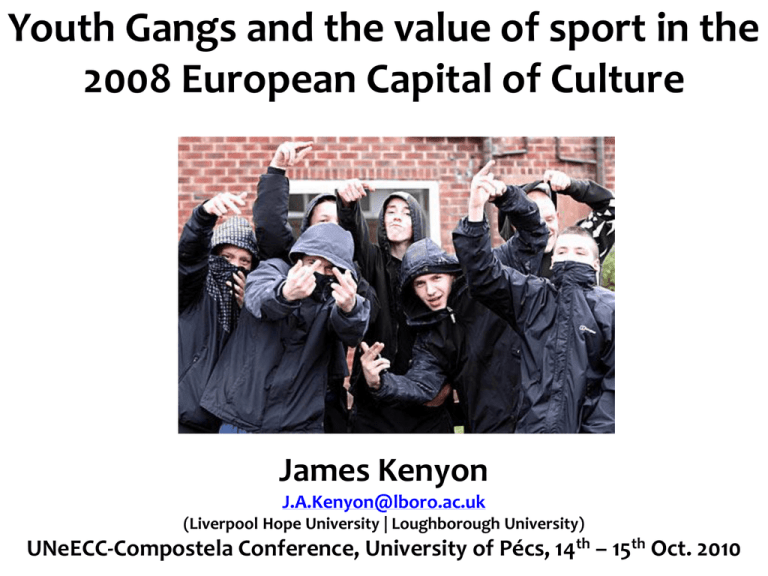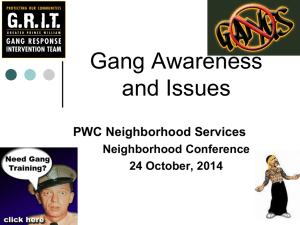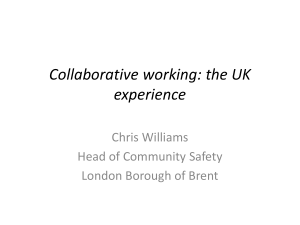ppt - UNEECC
advertisement

Youth Gangs and the value of sport in the 2008 European Capital of Culture James Kenyon J.A.Kenyon@lboro.ac.uk (Liverpool Hope University | Loughborough University) UNeECC-Compostela Conference, University of Pécs, 14th – 15th Oct. 2010 Introduction Gangs are not a newly conceived phenomenon Gangs have attracted a considerable (media and political) attention in the UK in recent years. Can be explained by increases in anti-social behaviour and knife and gun crime among elements of UK youth culture (Marshall et al., 2005) Overlooked by academics until recently Introduction Therefore… The aim of this research was to examine the extent to which community sports programmes serve as an effective tool in preventing youth engagement in gang culture Definitional Issues Gangs are difficult to define General consensus is: A durable group of young people, with a group identity, which are structured or organised (to a certain degree) and, at some level, are involved in criminal, delinquent or anti-social behaviours (Aldridge and Medina-Ariza, 2007; Hallsworth and Young, 2004) Background Since the beginning of Liverpool’s economic implosion in the 1960s/70s, the city has developed a (media-induced) reputation for: • anti-social behaviour • drugs • hooliganism • crime • and more recently… youth-gang culture (see for example, Boland, 2008; Doward, 2007) Background Liverpool was ‘first mainland city [in the UK] to have openly armed police officers patrolling the streets’ (Boland, 2008: pg. 361) Between 1994 - 1997, Merseyside was responsible for approximately 80% of the UK’s imported heroin (Anderson cited in Campbell, 1998: pg. 4) Between 2006 - 2007, in the 1st year of SOCA, Liverpool was revealed as being the UK's centre for organised crime outside London (Merrick, 2007) Background 2007 – 11 year old Rhys Jones killed in cross-fire of gang-related shooting Youth gang feud in Croxteth / Norris Green Significant coverage in national and international media - Young Gunmen (2008) - Ross Kemp on Gangs (2009) Reasons for Engagement (US) • • • • • • Excitement Identity Protection Conformity Fiscal reasons A family tradition (National Crime Prevention Council, 2006) Risk Factors for Engagement (UK) • • • • Lack of Education Training and Employability Criminal Lifestyles Thinking and Behaviour Problems (Dawson, 2008) Geographical Areas of Academic Interest 1. Edinburgh (e.g. Smith et al., 2001) 2. Manchester (e.g. Bennett and Holloway, 2004 ; Bullock and Tilley, 2002; Mares, 2001) 3. Liverpool (e.g. Bennett and Holloway, 2004; Dawson, 2008) 4. Birmingham (e.g. Bennett and Holloway, 2004; Dawson, 2008) 5. London (e.g. Bennett and Holloway, 2004 ; Dawson, 2008; Pitts, 2007) Key Research Contrary to popular belief (i.e. the media), gangs have a loose structure and lacked formal leadership (Mares, 2001) Which supports more current research that maintains the structure of youth gangs is ‘fluid, loose [and] messy’ (Aldridge and Medina-Ariza, 2007: 17) Most gang members are - to some degree - involved in violence, crime and/or drugs (either consuming or selling) (Aldridge and Medina-Ariza, 2007; Bullock and Tilley, 2002; Mares, 2001, Pitts, 2007; Smith, 2001). In most major cities in the UK with a significant gang problem, members are more likely to be young black males of African or Caribbean descent (Dawson, 2008; Mares, 2001) …except in Liverpool where almost all are white (Dawson, 2008) Why Sport??? Why Liverpool??? Community sport is considered to be a practical means of addressing society’s problems Anti-social behaviour is listed as the top priority in Liverpool’s Crime, Disorder, Anti-Social Behaviour & Drug Misuse Strategy 2005 – 2008 (Citysafe, 2005) Anti-social behaviour is more likely to be prevalent in underprivileged neighbourhoods (Utting, 1997) & Liverpool is the most deprived local authority in the UK (SRCD, 2008). Liverpool is famous throughout the world for its sporting icons and institutions (Boland, 2008; Kenyon & Rookwood, 2010; Rookwood, 2010) Almost two-thirds of population participate regularly (Sport England, 2006) Methodology Qualitative approach Online and offline ethnographic techniques Participant observation (PO), interviews (IV), focus groups (FG), content analysis Rich material, reliable evidence PO: details Perceptions of Problem Divergence in opinion concerning the extent of the problem. • expert-interviewees big problem • younger respondents not that big a problem Has the youth population in these deprived communities become desensitised to elements of criminality and anti-social behaviour to such a degree that they no longer consider certain behaviours to be anti-social or criminal, but more so, to be part of daily routine? Engagement & ‘Membership’ Daytime Activities • Playing football • Smoking marijuana (but not dealing) Night-time Activities • Drinking (usually only on a weekend) • Meeting up with girls However… The above is not too dissimilar from youth behaviour throughout the UK Engagement & ‘Membership’ No initiation ceremony ‘Membership’ came from ‘hanging around’ with friends who were already involved. There was usually no ‘leader’ Where there was, it was usually the young person considered to be the hardest (best fighter) Engagement & Community Sport Findings are consistent with previous research conducted on anti-social behaviour (Morris et al., 2003) Achieving reductions in engagement comes from decreasing the amount of unsupervised leisure time: ‘… it’s mainly down to boredom. The kids I’ve coached usually say that there’s nothing for them to do. And if they’ve got an interest in football and join our team, they train so many nights a week, they haven’t got as much time to be hanging around being bored’ (FG Resp.). Engagement & Community Sport The physical demands of sport are SOMEWHAT attributable in preventing engagement in gang culture and ASB ‘when they get back from training, they’re tired and they just want to relax’ (FG Resp.) ‘…it just takes it out of you when you play footy […] and then goin’ out and causin’ trouble and all that… be arsed?’ (FG Resp). Engagement & Community Sport Community sport can deter: • binge drinking • drug-taking sessions in the evenings preceding weekend participation. ‘Go ‘ed lad… I didn’t go out last night or anythin’. I’ve stopped all that the night before a game since I started playing for youse. Nice and fresh kid.’ Scouse-to-English Translation: Hello my friend… I decided not to go out drinking last night. I have stopped going out the night before we play since I signed for the football team. I like to feel nice and fresh for the game my friend. Long Term Benefits Findings are consistent with Nichols (1997) and Utting (1997) research into deviance and sport. Lasting benefits are achieved through: • Improvements in cognitive and social skills • Reductions in impulsive and risk-taking behaviours • Increases in self esteem and confidence • Improvements in education and employment prospects Conclusion It would be naïve to suppose that participation in community sport can eradicate all traces of engagement in ASB & Gang Culture But it can certainly reduce engagement! Community sport should (and must) be integrated into a wider holistic programme of community development. References • Aldridge, J. and Medina-Ariza, J. (2007). Youth Gangs in an English City: Social Exclusion, Drugs and Violence: Full Research Report ESRC End of Award Report, RES-000-23-0615. Swindon: ESRC • Bennett, T & Holloway, K. (2004). Gang membership, drugs and crime in the UK. British Journal of Criminology, 44: pp. 305 - 323. • Boland, P. (2008). The construction of images of people and place: Labelling Liverpool and stereotyping Scousers. Cities, 25: pp. 355 - 369. • Bullock, K. & Tilley, N (2002). Shootings, gangs and violent incidents in Manchester: Developing a crime reduction strategy. Crime reduction research series, Paper 13. London: Home Office. • Campbell, A. (1998). Mersey Kings of Evil Trade. Liverpool Echo, published 1st April, 1998 • Citysafe (2005). Crime, Disorder, Anti-Social Behaviour & Drug Misuse Strategy 2005 – 2008. Retrieved 24th October, 2009 from http://www.liverpool.gov.uk/Images/tcm21-41982.pdf • Dawson, P. (2008). Monitoring Data from the Tackling Gangs Action Programme. Home Office: London. • Doward, J (2007). Raised amid guns and gangs. The Guardian. Retrieved 12th of January, 2009 from http://www.guardian.co.uk/uk/2007/aug/26/ukcrime.ukguns • Hallsworth, S. and Young, T. (2008). Gang talk and gang talkers: A critique. Crime, Media and Culture, vol. 4, 175-195 • Kenyon, J. and Rookwood, J. (2010). ‘The world in one postcode?’ Examining the place of sport and perceptions of Liverpool’s European Capital of Culture experience. Poster presented at the International Journal of Arts & Sciences Mediterranean Conference for Academic Disciplines, February 15th – 18th, University of Gozo: Malta. • Mares, D. (2001). Gangstas or Lager Louts? Working class street gangs in Machester’. In, M. W. Klein, H. J. Kerner, C. L. Maxson, and E. G. M. Weitekamp (Eds.) The Eurogang Paradox: Street Gangs and Youth Groups in the US and Europe. London: Kluwer Academic Publishers. References • Marshall, B, Webb, B. and Tilley, N. (2005). Rationalisation of current research on guns, gangs and other weapons: Phase 1. University College London Jill Dando Institute of Crime Science: London. • Merrick, R. (2007). Liverpool revealed as centre for organised crime in North. icLiverpool. Retrieved 12th of January, 2009 from http://icliverpool.icnetwork.co.uk/0100news/tm_headline=liverpool-revealed-as-centre-for-organised-crime-innorth%26method=full%26objectid=20127351%26siteid=50061-name_page.html • National Crime Prevention Council (2006). Identifying and Addressing a Gang Problem. Arlington: National Crime Prevention Council. • Nichols, G. (1997). A consideration of why active participation in sport and leisure might reduce criminal behaviour. Sport, Education and Society, 2(2): pp. 181-190. • Pitts, J. (2007). Violent youth gangs in the UK. Safer Society: The Journal of Crime Reduction and Community Safety, 32: pp. 14 – 17. • Rookwood, J. (2010). ‘We’re not English we are Scouse!’ Examining the identities of Liverpool Football Club supporters. In, Sport and Social Identity: Studies from the Field. (Eds. J. Hughson, F. Skillen and C. Palmer). Lewiston: Edwin Mellen Press. [In Press] • Smith, D., J., McVie, S., Woodward, R., Shute, J., Flint, J. and McAra, L. (2001) The Edinburgh Study of Youth Transitions and Crime. Edinburgh Study of Youth Transitions and Crime Research Digest No. 1. • Social Disadvantage Research Centre (2008) The English Indices of Deprivation 2007. Communities and Local Government: London. • Sport England (2006) Understanding the Success Factors in Sport Action Zones. Final Report. London: Sport England. • Utting, D. (1997) Reducing Criminality Among Young People: A Sample of Relevant Programmes in the United Kingdom. London: Home Office Research and Statistics Directorate.






